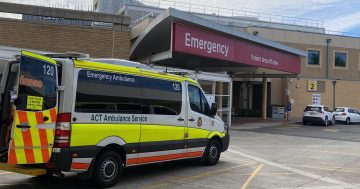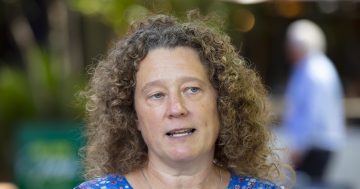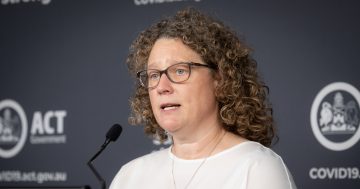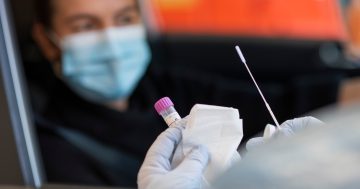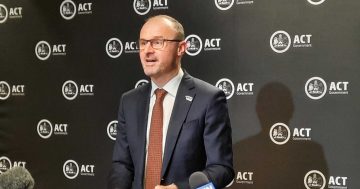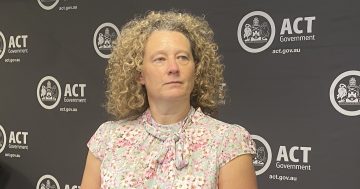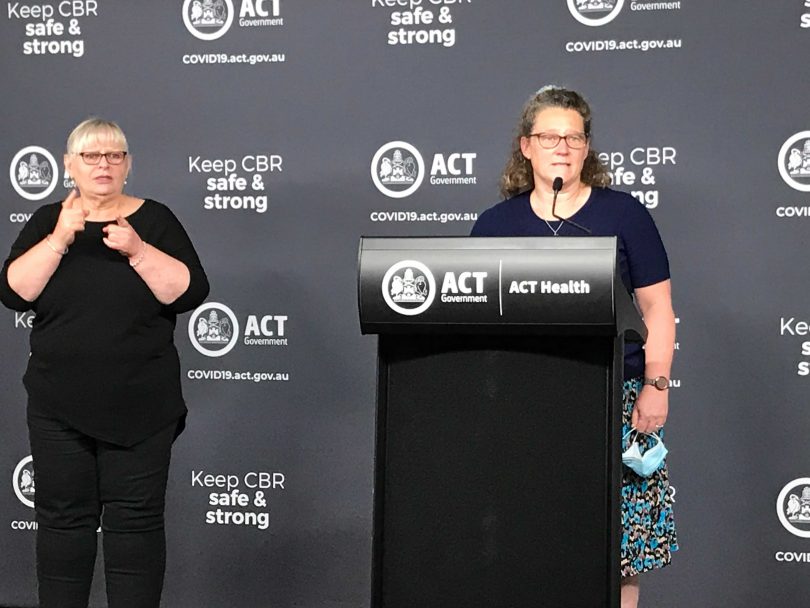
Chief Health Officer Dr Kerryn Coleman said case numbers would rise as social interactions increased. Photo: Lottie Twyford.
UPDATED 3:15 pm: The ACT is moving to a more flexible, nuanced approach to contact tracing and case response as vaccination rates rise and the Territory prepares for lockdown to lift and public health measures to ease.
Chief Health Officer Dr Kerryn Coleman has reiterated that case numbers will rise with the increased movement of people and ACT Health will be moving to more of a risk management model.
Dr Coleman said discussions were continuing about the value of including all categories in contact tracing (close, casual and monitor for symptoms), saying that in the future there will be a big focus on close contacts and household contacts, and much less on casual contacts.
She said NSW and Victoria had to switch to alternative models to focus on those at highest risk because daily case numbers are so high.
Dr Coleman said that may mean that a casual contact in for example a supermarket may not attract the same kind of attention and response as it does now.
“That’s what our information and data is definitely confirming, that we are really not seeing transmission from those sites, which is incredibly reassuring,” Dr Coleman said.
“So this is a balance about saying how do we get on with our lives in a COVID-normal, COVID-safe manner, but also focusing on what cases do we really need to know about, what contacts do we really need to know about for when they become cases so we can protect those settings and people who are much more likely to have those adverse outcomes or those poor health outcomes.
“We will be making some changes, we just need a little bit of time to make sure they’re done in a way that doesn’t make us go backwards.”
ACT Health is also looking at different responses to school outbreaks that do not lockdown entire campuses.
Dr Coleman said this could involve just focusing on specific classes or assessing risk based on the vaccination status of students, treating people differently depending on whether they are fully vaccinated or not.
That could be announced next week.
She would not be drawn on how many cases would be too high to proceed with lifting lockdown, but suggested there was a fair amount of tolerance.
“I’d really like our case numbers to be as low as possible before we progress to the next stage but I also think the days of teens for daily case numbers are over,” Dr Coleman said.
“We are expecting that our case numbers will be higher than we’ve seen before.
“Hopefully they won’t go too far over 50 before we get to the easing of lockdown step.
“I will l do everything I can to ensure that lockdown lifts on 15 October.”
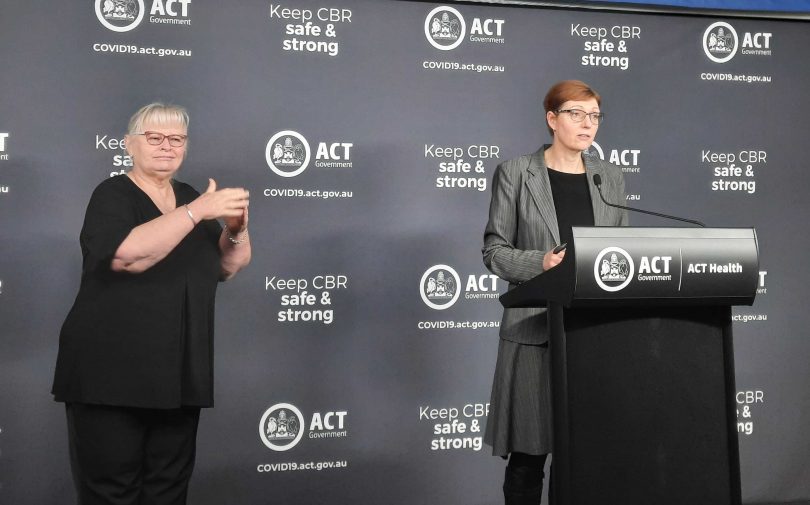
Health Minister Rachel Stephen-Smith at this morning’s COVID briefing. Photo: Ian Bushnell.
UPDATED 12:30 pm: There are 33 new cases of COVID-19 in the ACT.
Of the new cases, 28 are linked to current sites or close contacts, 18 are household contacts but just six were in quarantine during their entire infectious period.
At least 14 people spent time in the community, although 13 of those have been assessed as being of minimal risk.
There are currently 14 people in hospital with COVID and five are in intensive care, three of whom are being ventilated.
Yesterday, 2500 tests were carried out.
“We expect to see larger daily case numbers and will need to accept that a degree of transmission in the ACT is inevitable, mostly due to the highly contagious nature of Delta combined with more people moving around as we ease restrictions,” Chief Health Officer Dr Kerryn Coleman said at today’s COVID briefing.
Dr Coleman provided an update on the outbreak’s epidemiology following the large increase in case numbers last week. The average number of cases has now increased to 132 per week and the proportion of positive tests has risen from 0.7 per cent to almost 2 per cent.
“What this helps to tell us is that there’s a true increase in cases, not just an increase in testing,” Dr Coleman said.
Approximately 70 per cent of people presenting for testing are close or household contacts, reflecting slightly relaxed social conditions and household visits.
“More mixing means more cases but we are detecting them,” Dr Coleman said.
The median age of positive cases in the outbreak is 28, over half the patients are male and 53 per cent of cases are between 18 and 44 years. A total of 95 people have been admitted to hospital, or 9 per cent of all cases. Sixteen have required intensive care and eight have required ventilation.
Of the 95 admissions, 68 were unvaccinated, 16 have received one dose and five have been fully vaccinated.
“This highlights for me, and hopefully all of you, the importance of getting vaccinated as soon as possible,” Dr Coleman said.
There are 80 cases where the source of transmission is unknown and more than 50 who are still being investigated including newer cases. Dr Coleman said this information will also lessen in importance as the focus moves from halting the outbreak to protecting the most vulnerable.
There have been 38 separate clusters since 12 August, many involving essential workers.
But Dr Coleman said there were still worrying delays in the time people take to get tested: 40 per cent of people are waiting more than five days from the onset of symptoms, while one in 10 people are waiting more than 10 days.
Alarmingly, Dr Coleman said some cases are waiting up to 13 days.
“These statistics are going in the wrong direction,” she said.
“We are currently on track with timeframes to ease restrictions on 15 October but things can very quickly change as we have seen.
“We must now stay the course, we have to be vigilant … when current lockdown restrictions are raised on the 15th, we need to be in the strongest possible position. As we change public health measures, we want to lowest possible case numbers and highest possible vaccination numbers.”
Health Minister Rachel Stephen-Smith said there had been 106 compliance checks, 1310 traffic stops and 22 people were directed to leave the ACT. Three infringement notices were issued.
On the vaccination front, 94 per cent of the eligible 12-plus population has received one dose of vaccine, and 65 per cent are fully vaccinated.
Ms Stephen-Smith said that vaccination appointments are available today through government clinics, GPs and pharmacies.
She also outlined the proposals for mandatory vaccination among health care workers, where frontline staff face higher infection risks especially when patients are asymptomatic on presentation.
The proposed vaccination requirements will apply to all frontline health care workers in any Canberra Health facility, including day surgery hospitals, hospices and ambulance and other patient transport workers.
Consultation began this morning with the health workforce and other key stakeholders to finalise the direction. It’s currently proposed that all workers must have at least one dose of vaccine by 29 October and their second dose no later than 1 December. The Minister said a phased approach to other health care workers was being considered in line with national recommendations.
11:55 am: The ACT has recorded 33 new cases of COVID-19.
Yesterday there were 28 cases.
Of the new cases, 28 are linked to current exposure sites or contacts (18 are household contacts); five are under early investigation.
Six were in quarantine for the entirety of their infectious period, but at least 14 spent part of their infectious period in the community.
There are 14 people in hospital with COVID, five are in ICU and three require ventilation.
More than 2500 tests were conducted yesterday. Health Minister Rachel Stephen-Smith said it was a strong number for a public holiday.
ACT Policing conducted 106 in-person compliance tests and 1310 drivers were stopped under the current health orders. There were 22 directions to leave the ACT and three infringements were issued.
NSW has reported 608 new cases and seven deaths. There are currently 190 patients in ICU.
Yesterday, 623 new cases and six deaths.
Victoria has recorded 1763 new cases in the past 24 hours, the worst single-day spike in cases, and four deaths.
Yesterday, 1377 new cases and four deaths.
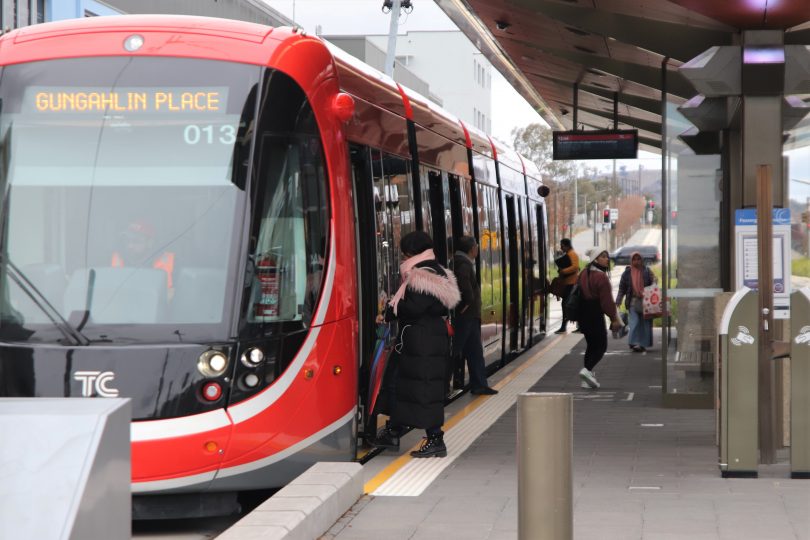
Light rail has been identified as a new casual exposure site. Photo: Damien Larkins.
10 am: A number of public transport routes are among the new casual exposure sites as Canberra’s COVID-19 outbreak grows.
The Florey School Holiday Program remains the only recently added close contact site, updated to include Friday between 7:50 am and 5:00 pm, while new casual exposure sites have been identified in Ainslie, Civic, Lyneham, Narrabundah, Phillip and Wanniassa.
There are a range of new monitor for symptom sites across the city in Ainslie, Amaroo, Downer, Franklin, Greenway, Holt, Macquarie, Mawson and Mitchell.
The Light Rail Route 1 from Alinga Street to the Dickson Interchange is a casual exposure site for Tuesday, 28 September between 11:50 am and 11:56 am, and from Phillip Avenue to Alinga Street on Monday, 27 September between 10:43 am and 10:54 am.
From Tuesday, Bus Route 9 Code BUS395 from Dickson Interchange to Watson is a casual exposure site between 11:59 am and 12:06 pm. On the same day and route, Code BUS544 from Watson to Dickson Shops between 4:24 pm and 4:31 pm and Code BUS631 from Dickson to Watson between 5:46 pm and 5:51 pm are casual exposure sites.
On Wednesday, Bus Route 9 is a casual exposure site for BUS592 travelling between Dickson Interchange and Watson from 3:28 pm to 3:38 pm; BUS695 from Watson to Belconnen (Cohen Street) from 9:50 am to 10:20 am and BUS713 Watson to Dickson between 1:51 pm and 2:00 pm.
On Friday, also on Bus Route 9, BUS660 from Dickson Shops to Watson on Friday between 11:04 am and 11:13 am, and BUS561 from Watson to Dickson Interchange on Friday between 10:20 am and 10:27 am is a casual exposure site.
On Bus Route 51, BUS379 Dickson Interchange to O’Connor Shops on Wednesday from 2:21 pm to 2:36 pm is a casual exposure site, as is BUS691 from O’Connor Shops to Dickson Interchange on the same day from 3:11 pm to 3:28 pm.
On Bus Route 24 BUS452 from Belconnen Interchange to Evatt (William Webb Drive) is a casual exposure site on Sunday, 26 September from 6:20 pm to 6:26 pm; on the same route, BUS318 Evatt (William Webb Drive) to Belconnen Interchange on Friday, 24 September between Friday 9:02 am and 9:10 am is also a casual exposure site.
The Canberra International Golf Centre (Driving Range only) is a casual exposure site for Sunday, 3 October from 1:25 pm to 2:30 pm, as is the Ainslie Takeaway on Friday between 11:00 am and 8:00 pm and Saturday between 2 pm and 8 pm; as is Coles Canberra Centre on Tuesday between 9:30 am and 10:20 am.
Other new casual sites include Coles Wanniassa, Saturday from 4:55 pm to 6:00 pm and Monday 6:55 pm to 7:45 pm; PharmaSave Woden Westfield Woden, Tuesday 1:50 pm to 2:50 pm; IGA Lyneham on Thursday from 3:15 pm to 4:00 pm; and Akiba on Bunda St on Saturday between 4 pm and 7 pm.
The wait time for testing at EPIC and the drive-through at Kambah are around 15 minutes; minimal wait times have been reported at other sites across the ACT.
The complete list is available at covid19.act.gov.au.












